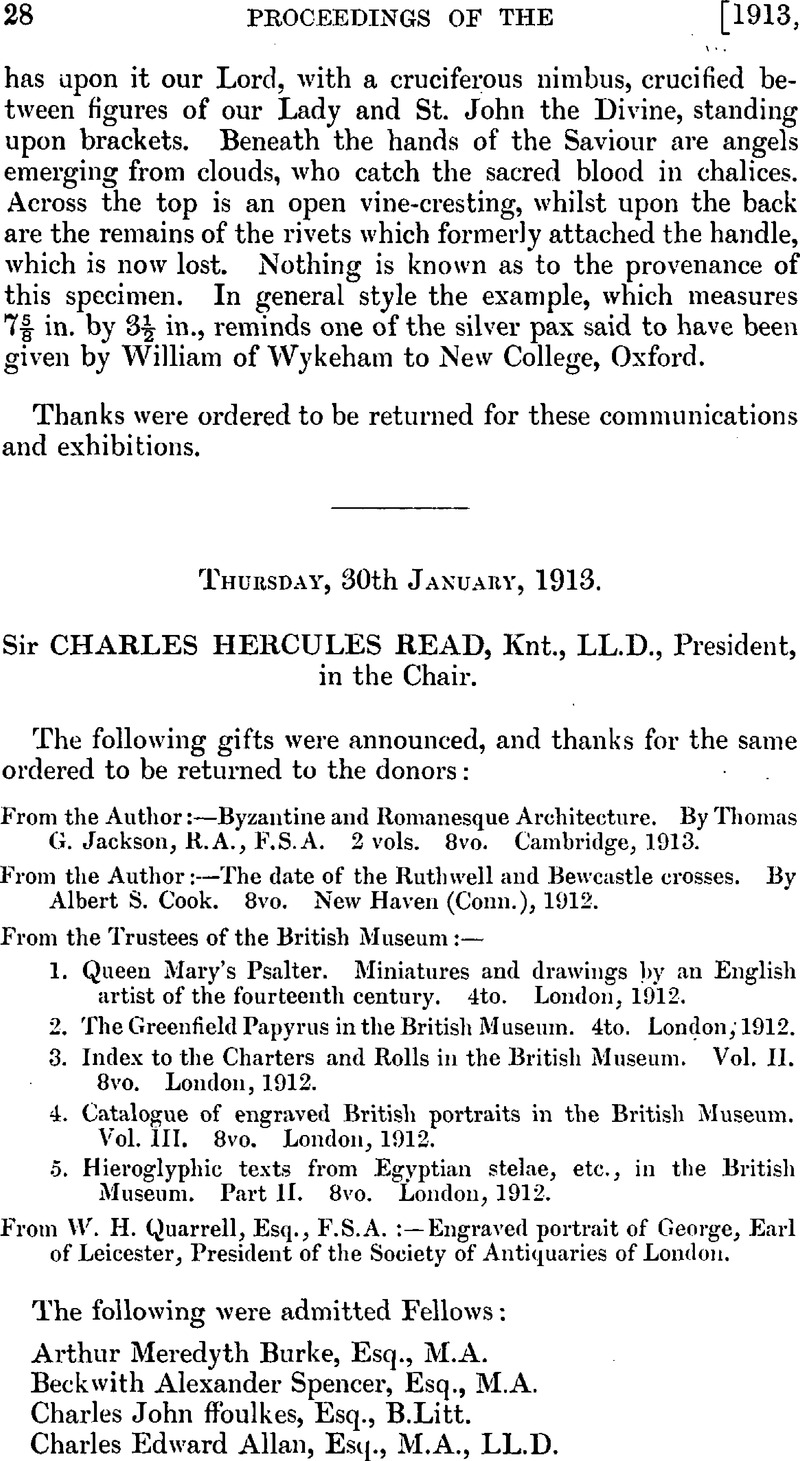No CrossRef data available.
Article contents
Thursday, 30th January, 1913
Published online by Cambridge University Press: 10 May 2010
Abstract

- Type
- Proceedings
- Information
- Copyright
- Copyright © The Society of Antiquaries of London 1913
References
page 29 note 1 Archaeologia, lxii. 367.
page 30 note 1 Ed. Hearne, p. 366, quoting a Stannary Charter.
page 30 note 2 Ed. Chron. and Mem., p. 812.
page 31 note 1 Record Commission ed., 206.
page 31 note 2 No. 117.
page 33 note 1 No doubt the official apologists of the Exchequer all drew upon the same sources : one of these was probably the bundle of papers (Exchequer of Receipt, Miscellanea, 396) accumulated at the end of the reign of Elizabeth during the quarrel and proceedings between the Clerk of the Pells and the Auditor, or Scriptor Talliarum : an interesting collection (since it gives us details of Henry VII's sweeping reforms at the Receipt) but unfortunately containing very little about tally-cutting.
page 33 note 2 Note the rather vague words day ami yeare : the original practice was the term and regnal year. Later than the time we are discussing, these were retained with the addition of the day, as is seen in the tallies belonging to Martin's Bank. Finally, as appears from nineteenth-century specimens, the modern day and year were written.
page 35 note 1 Calendar of Close Rolls, 1327–30, p. 269.
page 35 note 2 Ibid, p. 277.
page 35 note 3 The practice of assignment was understood, apparently, as early as the reign of Henry II (see an article on ‘William Cade’ in the English Historical Review, April, 1913); but before the practice became general a special writ was used in each case, not the tally.
page 35 note 4 Issue Roll, 231.
page 35 note 5 Receipt Roll, 255.
page 35 note 6 L. T. R. Memoranda Roll, 93, m. 26.
page 35 note 7 Ibid., m. 89 d.
page 35 note 8 Ibid., Trin. Stat. et Vis: Comp.
page 35 note 9 I am again wholly indebted to Professor Willard for these examples, incorporated in the present note since the time of its reading.
page 36 note 1 Receipt Roll, 413, under the dates July 13, 25, 28, 29,1357, there are tallies drawn against the collectors of the fifteenth and tenth in various counties although their payments were not due until Michaelmas and Easter.
page 36 note 2 Receipt Roll, 415.
page 36 note 3 Receipt Roll, 415, February 28, March 5, 8 ; Receipt Roll, 419.
page 37 note 1 Receipt Roll, 413.
page 37 note 2 L. T. R. Memoranda Roll, 130, m. 237 d. Status et Visus Compotorum, Trinity Term, m. 10 d.
page 37 note 3 Receipt Roll, 413.
page 37 note 4 Receipt Roll, 419, under tlie dates April 12, June 9, &c.
page 38 note 1 My attention was called to them by Mr. W. W. Skeat, and I was enabled to handle them by the kindness of Mr. David Baxendall of the Science Museum.
page 44 note 1 Proceedings, xx. 130.




